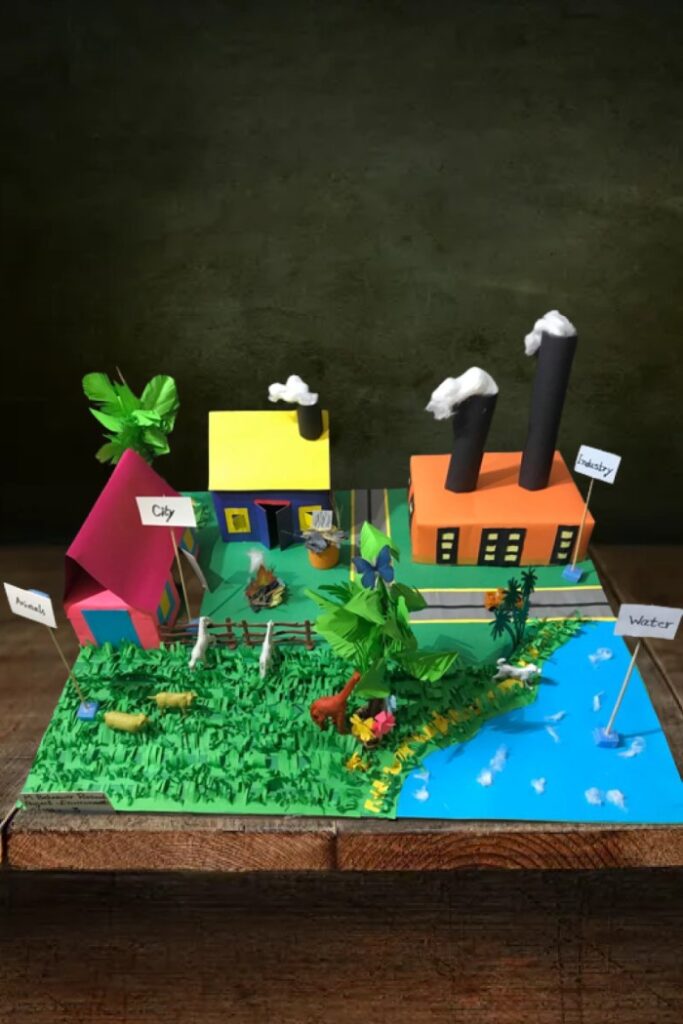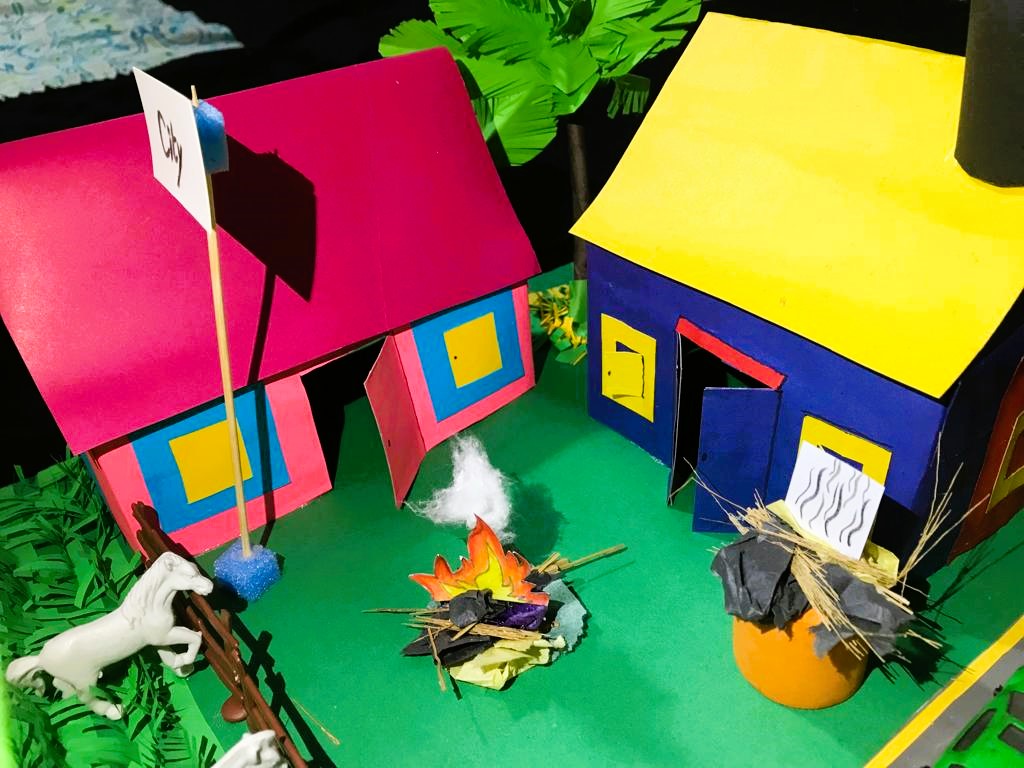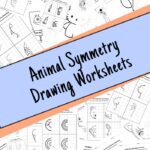Air pollution has become one of the most pressing environmental issues of our time. From smog-filled skies to harmful industrial emissions, polluted air affects not only human health but also animals, plants, water, and the overall balance of our planet. To spread awareness and help students learn about the harmful effects of air pollution, creating an environmental air pollution 3D model is a great idea.
In this post, I will share my 3D science project on air pollution, which I designed using chart paper, cardboard, and cotton. The model highlights various aspects of our environment, such as cities, industries, water, and animals, while explaining how pollution from industries spreads into the air and affects living organisms. This project can be displayed on World Environment Day, at science fairs, or during classroom activities to promote eco-friendly practices and environmental protection.

Why Choose an Air Pollution Model for a School Project?
Air pollution is something that children see around them every day—smoke from factories, cars on the road, garbage burning, or dusty environments. By creating a hands-on 3D project model, students can:
- Understand the sources of air pollution (industries, vehicles, burning waste).
- Learn how pollution spreads through air, water, and soil.
- Recognize the harmful effects on humans, animals, and plants.
- Discuss solutions to reduce pollution.
When students create something tangible with their hands, it leaves a stronger impact on their minds than just reading a chapter from a book.
Materials Used in My Environmental Pollution 3D Model
To make the model visually attractive yet simple, I used the following easily available craft materials:
- Chart papers (different colors for houses, roads, and water bodies)
- Cardboard sheets (for base and buildings)
- Cotton balls (to show factory smoke)
- Toy animals or clay animals (to represent the effect on wildlife)
- Paper cutouts of trees and plants
- Color markers and sketch pens for labeling
- Glue, tape, and scissors for assembling the model
The best part is that these are low-cost, eco-friendly materials that students can easily find at home or in school.
Step-by-Step Explanation of the Model
My 3D project shows four major areas:
- City
- Industry
- Water
- Animals/Nature
Each section represents a unique aspect of the environment and how it is affected by pollution. Let me walk you through the sections of the model:
The City Area

I created a small city setup with houses made of colored chart paper. The roads are drawn on cardboard with yellow dividers, and I placed toy cars to represent traffic. This area represents urban life where people live and vehicles move around daily.
Message: In real life, cities face severe air pollution from vehicle emissions, garbage burning, and construction dust. The model highlights how urban activities contribute to the overall pollution problem.
The Industry Section

On the other side of the road, I made an orange factory building using cardboard. To represent the chimneys, I used rolls of black paper and placed cotton balls on top to make it look like smoke was coming out.
Message: Factories and industries emit harmful gases like carbon dioxide, sulfur dioxide, and nitrogen oxides. These emissions not only pollute the air but also contribute to acid rain and global warming.
The Water Body
In one corner, I added a blue chart paper body of water to represent a river or lake. I placed pieces of cotton wool floating in the water to show the polluted foam and waste.
Message: Industries often release wastewater into rivers, which mixes with clean water and affects aquatic life. Polluted water becomes unsafe for drinking and damages biodiversity.
The Animal Section
On the green side of the model, I added toy animals like goats, cows, and birds to illustrate how pollution affects living things. A cardboard fence separates the area, while paper trees and plants decorate the natural environment.
Message: Animals suffer when air pollution contaminates the environment. They breathe polluted air like humans, and their health also declines when water and grass are polluted.
How This Model Demonstrates Pollution
The beauty of this project is that it brings together all aspects of pollution:
- Industrial smoke (cotton) pollutes the air.
- The polluted air reaches the city where humans live.
- The industrial waste flows into the water body, harming aquatic animals.
- The polluted air and polluted water affect farm animals and plants.
It visually shows how everything in the environment is interconnected. Pollution in one area spreads and harms the entire ecosystem.
Educational Importance of the Project
This 3D project isn’t just a craft – it holds an important environmental lesson. Students, teachers, and parents can discuss:
- Sources of pollution – industries, vehicles, waste burning.
- Effects on human health – breathing problems, allergies, lung diseases.
- Effects on nature – deforestation, loss of biodiversity, and animal deaths.
- Effects on water – polluted rivers, unsafe drinking water, and fish deaths.
- Global effects – climate change, global warming, melting glaciers.
By looking at the model, even young children can easily understand the pollution cycle and its consequences.
Solutions to Reduce Air Pollution (For Discussion in Project)
A project solution on air pollution should also be highlighted so that students learn how to save the environment. Some eco-friendly ideas are:
- Plant more trees to clean the air.
- Use public transport, bicycles, or carpooling to reduce vehicle emissions.
- Install filters in factories to control harmful gases.
- Avoid burning waste and promote recycling.
- Shift to renewable energy sources such as solar and wind.
- Spread awareness through campaigns, posters, and school activities.
Using This Project on World Environment Day
World Environment Day is celebrated every year on June 5th to encourage global awareness and action to protect our planet. This project can be displayed as part of celebrations in schools. Students can present it to teachers and classmates, explaining how human activities are damaging the environment and how we can make a difference.
Watch the Project Video
To understand this model in detail, I have also created a short video where you can take a closer look at the environmental air pollution 3D model. The video gives a clear view of each part, including the city, industry, animals, and water bodies, as well as explaining how pollution from factories spreads into the air and affects the environment.
This visual explanation makes it easier for students to learn and present the project confidently at school exhibitions or on World Environment Day.
Final Thoughts
Creating a 3D model of environmental air pollution is a fun, creative, and educational way to raise awareness about one of the biggest challenges facing our planet today. With just chart paper, cardboard, and cotton, students can create a realistic model that highlights the issues of city pollution, industrial smog, water pollution, and the effects on animals.
This project is not just for numbers or competitions — it is a reminder to all of us that protecting the environment is everyone’s responsibility. When children learn about pollution through such creative activities, they grow up to be more responsible citizens who care about nature.
So, whether it’s for a school exhibition, science fair, or World Environment Day celebration, try making this project. It will not only impress the audience but also spread a strong message:
“Save the Earth, Save Life – Stop Pollution!”




I have been absent for a while, but now I remember why I used to love this blog. Thank you, I will try and check back more frequently. How frequently you update your web site?
Welcome back! I’m glad you still enjoy the blog 😊. I try to update it weekly.
Pingback: DIY Popsicle Stick House | School Craft Project - 1thousandideas
Great write-up, I?¦m regular visitor of one?¦s blog, maintain up the excellent operate, and It’s going to be a regular visitor for a lengthy time.
Hello there, You’ve performed a great job. I will certainly digg it and for my part recommend to my friends. I’m confident they will be benefited from this website.
I have been browsing online more than three hours today, yet I by no means discovered any interesting article like yours. It is lovely price sufficient for me. Personally, if all webmasters and bloggers made good content as you probably did, the internet might be much more helpful than ever before.
I really appreciate your kind words. It’s great to hear that my content is helpful to you.
Your place is valueble for me. Thanks!…
You could definitely see your expertise in the work you write. The world hopes for more passionate writers like you who aren’t afraid to say how they believe. Always go after your heart.
Nice read, I just passed this onto a colleague who was doing some research on that. And he just bought me lunch since I found it for him smile Thus let me rephrase that: Thank you for lunch! “We have two ears and one mouth so that we can listen twice as much as we speak.” by Epictetus.
You’re welcome. I’m glad the information was useful for your colleague as well
I got what you mean , regards for putting up.Woh I am lucky to find this website through google.
I like what you guys are up also. Such intelligent work and reporting! Keep up the superb works guys I have incorporated you guys to my blogroll. I think it’ll improve the value of my site :).
Hi there! This is my first visit to your blog! We are a group of volunteers and starting a new project in a community in the same niche. Your blog provided us useful information to work on. You have done a outstanding job!
Awsome post and straight to the point. I am not sure if this is actually the best place to ask but do you folks have any ideea where to hire some professional writers? Thank you 🙂
Thank you! I’m not sure about hiring writers because I write all my blog posts myself.
Very detailed
Hey I am so glad I found your website, I really found you by mistake, while I was looking on Bing for something else, Regardless I am here now and would just like to say cheers for a tremendous post and a all round entertaining blog (I also love the theme/design), I don’t have time to browse it all at the minute but I have saved it and also added your RSS feeds, so when I have time I will be back to read a lot more, Please do keep up the fantastic job.